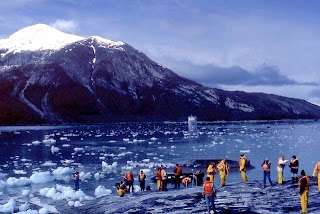 history’s greatest scientist and one of its greatest travelers, who changed the way we look at the world. Recalling five years aboard HMS Beagle, Darwin wrote that the part of the landscape that remained longest in his memory was the Patagonian steppe, but he also left a vivid description of some of the world’s wildest terrain at South America’s southern tip:
history’s greatest scientist and one of its greatest travelers, who changed the way we look at the world. Recalling five years aboard HMS Beagle, Darwin wrote that the part of the landscape that remained longest in his memory was the Patagonian steppe, but he also left a vivid description of some of the world’s wildest terrain at South America’s southern tip:“The scenery here becomes even grander than before. The lofty mountains on the north side compose the granitic axis, or backbone of the country, and boldly rise to a height of between three and four thousand feet, with one peak above six thousand feet. They are covered by a wide mantle of perpetual snow, and numerous cascades pour their waters, through the woods, into the narrow channel below. In many parts, magnificent glaciers extend from the mountain side to the water's edge. It is scarcely possible to imagine anything more beautiful than the beryl-like blue of these glaciers, and especially as contrasted with the dead white of the upper expanse of the snow. The fragments which had fallen from the glacier into the water, were floating away, and the channel with the icebergs presented, for the space of a mile, a miniature likeness of the Polar Sea.”
In honor of Darwin, I’ll be giving away one copy of the new edition of Moon Handbooks Patagonia to the first person who can name the island depicted in the photograph above, which Darwin visited aboard the Beagle, and which I will be visiting again next week aboard the small cruise ship Via Australis. Please send your answer to me at the following email address: southerncone (at) mac.com. Previous quiz winners, please let someone else have a chance (but feel free to send me the answer anyway).

No comments:
Post a Comment